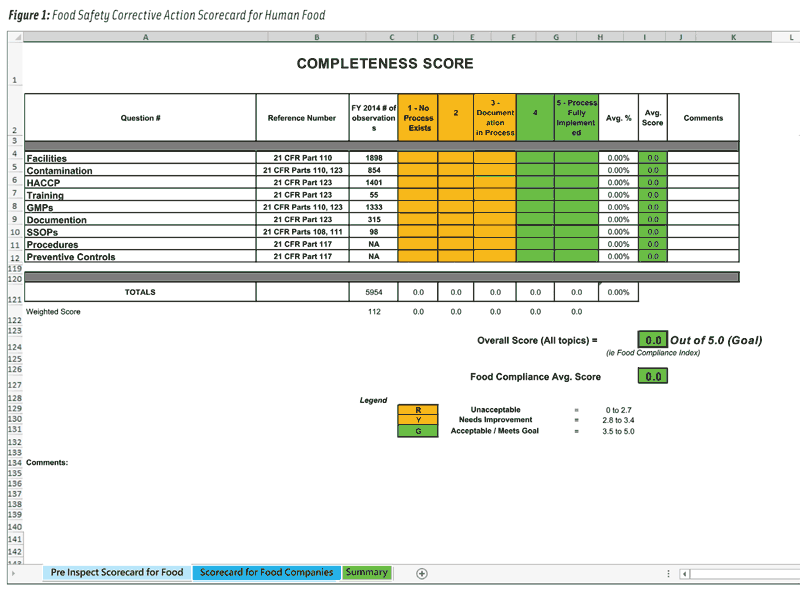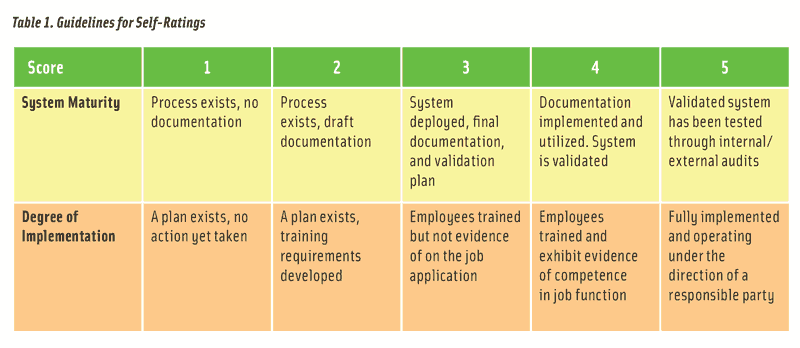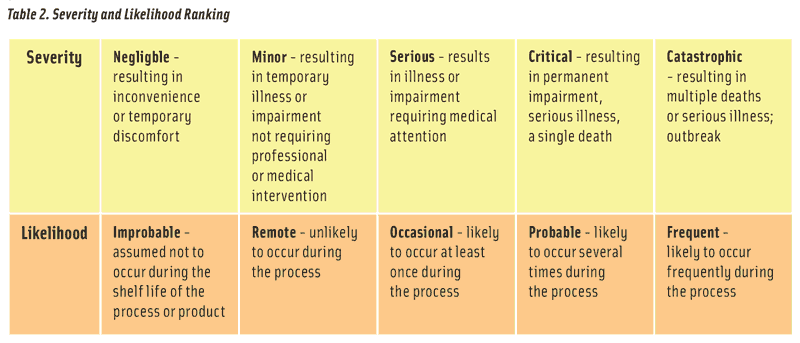Scorecard Tool Assists with FSMA Compliance
Self-assessment scorecard helps food companies to bolster their food safety through identifying areas of improvement and completing corrective actions.
A self-assessment tool developed by the Quality Leader Network (QLN) Metrics/Cost of Quality Team enables the food industry to identify and complete corrective actions within the Food Safety Modernization Act (FSMA) framework, set up working plans, and gauge their status against regulatory feedback received from the U.S. Food and Drug Administration (FDA). The free tool, “Food Safety Corrective Action Scorecard for Human Food”, which is available to food manufacturers, regulatory professionals, consultants, academia, professional organizations, governmental agencies, and other interested parties, is designed to assist in achieving compliance with 21 CFR 117 “Current Good Manufacturing Practice, Hazard Analysis, and Risk-Based Preventive Controls for Human Food,” issued by the FDA last fall as part of the FSMA implementation.
A corrective action in the food industry is an activity to eliminate the cause of a detected nonconformity or other undesirable situation. Corrections are steps taken to identify and correct a minor, isolated problem in a timely manner that occurs during food production. Corrective actions include actions to identify a problem with preventive control implementation, to reduce the likelihood the problem will recur, evaluate affected food for safety, and prevent it from entering into commerce (FDA 2015a). Both corrections and corrective actions must be documented with records, including verifiable evidence, demonstrating their effectiveness.
Food Safety
Annually in the United States, an estimated one in six individuals becomes ill from foodborne illness, equaling 48 million people. Of those, over 120,000 people are hospitalized and 3,000 people perish each year. The majority of foodborne illness is caused by unspecified agents and allergies. However, about 20% of cases are associated with 31 known pathogens (e.g., bacteria, viruses, and other microbes), of which the most common are norovirus, Salmonella, clostridium, campylobacter, and staphylococcus (CDC 2015). The food handling chain originates at the farm and concludes at the fork (Shetty 2006). Any step along the way can introduce or add to contamination that could cause foodborne illness. Thus, contaminated food can affect vulnerable populations such as in hospitals, daycare centers, nursing homes, and schools (York et al. 2009).
Globalization presents the potential for food to be destined for international markets with pathogens crossing national borders (Murphy et al. 2011). Indeed, the “mad cow disease” outbreak in the UK in the late 1980s was treated as global because it involved the meat supply around the world. Therefore, food safety is a public health issue of merit.
From Jan. 2, 2015, through Dec. 2, 2015, the FDA (2015b) recorded over 350 recalls, market withdrawals, and safety alerts related to food. The negative publicity and public concern over food safety, coupled with the medical expenses for those who become ill, can negatively impact the economy of affected companies and the healthcare system.
President Obama signed FSMA into the law on January 4, 2011, the first change in the food reform legal framework in about 70 years. The FDA (2015c) is responsible for implementing this new legislation. The common practice has been to react to outbreaks of foodborne illness. To address this practice, one of the provisions of FSMA is focusing on prevention by using current risk management principles (FDA 2015c).
Scorecard Development and Use
The QLN Metrics/Cost of Quality Team developed a scorecard for supporting the successful completion of corrective actions in the food industry. A scorecard is a simple and easy to use statistical tool to measure achievement or progress toward a particular goal.
The Food Safety Corrective Action Scorecard for Human Food is based on MS Excel to allow access to a broader audience. The users of the scorecard answer questions in various sections regarding compliance to FDA food regulations by providing a score from 1 to 5, with 1 being no process exists and 5 being the process is mature and fully implemented for that item. Table 1 describes the criteria for the self-rating.
The scorecard contains formulas for performing mathematical calculations, which are transparent to the users. Those calculations result in scores obtained from weighted averages taking into consideration the compliance level of the user, such that the greater the self-assessed compliance, the higher the score.
The resulting scores allow users to identify areas of improvement.
To determine the scorecard inputs, the Cost of Quality Team reviewed relevant standards and existing publically available metrics, both within and outside the food industry. The team included in the scorecard the top 40 FDA inspectional observations for food companies from 2010 to 2014 as stated in the Inspectional Observation Summaries for these years on the FDA website (FDA 2015d). These entries also cover the vast majority of reasons for food and meat recalls over the same period as recorded on FDA relevant warning letters. The team also consulted public information from the website of the Food Safety Inspection Services (FSIS) public health agency within the U.S. Dept. of Agriculture (USDA) to gather inputs pertaining to meat and poultry. All inputs were refined by soliciting input from the QLN Food Group to determine those most relevant to food industry needs.
The resulting scorecard includes: 1) categorization of major FDA food industry regulatory risk areas, 2) subcategories of observations identified by the agency for the year 2014, 3) code of federal regulation (21 CFR) references applicable to each observation, 4) categorization of risk (e.g., severity and likelihood determined as shown in Table 2), 5) criteria for self-assessment measures against each category, and 6) an overall rating of the self-assessed degree of compliance. Additionally, the electronic worksheet scorecard contains three tabs: 1) an overview pre-assessment for the general user, 2) a more detailed assessment for individuals responsible for food safety, and 3) a summary of the results of the Scorecard for Food Companies with entries for recording the problem situation, actions taken, affected product, product disposition, and corrective action closing. As indicated on the last tab, this scorecard tool can also be used as a Preventive Action tool.
The Food Safety Corrective Action Scorecard for Human Food is available free to the public at www.easyfsma.com/tools. Easyfsma.com is a website sponsored by the American Society of Quality (ASQ) Food, Drug, and Cosmetic Division and the QLN Food Group. Its purpose is to provide supporting material to small- and medium-size organizations pursuing FSMA compliance.
Shaping the Scorecard
Through ongoing interaction between the QLN Metrics/Cost of Quality Team, QLN Food Group, and FDA food industry subject experts, the Food Safety Corrective Action Scorecard for Human Food is being continually refined and updated with the changes FSMA is introducing into the food industry. The scorecard development team is currently looking for individuals and organizations interested to pilot the scorecard. Ultimately, this tool would enable a food company to benchmark its self-assessment against external inputs via audits and inspections.
It is the aspiration of the QLN Metrics/Cost of Quality Team that the scorecard be instrumental in assisting food manufacturers and those working in the regulatory field to accelerate their understanding and compliance with the relevant FDA regulations. The team would also encourage companies and others to upgrade this tool to adapt it to the desired level of detail and address unique business circumstances that companies experience. Those improvements will help companies to provide a better and safer product to the public. Based on the feedback received, the methodology used to develop this tool can also be applied to different FDA regulated commodities and is not solely limited to food manufacturing.
Aura Stewart is President, Nutripromise LLC, Austin, TX 78733 ([email protected]). Glenn D. Yeik is President and COO, Trimedyne, Inc., Irvine, CA 92618 ([email protected]). Lewie Casey is Quality and Regulatory Talent Manager, MEIRxRS, Glendale, CA 91203 ([email protected]). Marlene Garcia Swider is Quality System Manager, Los Angeles District Office, Food and Drug Administration, Irvine, CA 92612 ([email protected]). Niedre M. Heckman is Sr. Mgr. Global Regulatory Affairs, Baxalta US Inc., Westlake Village, CA 91362 ([email protected]). Roger Clemens, a professional member of IFT, is Adjunct Professor, USC School of Pharmacy, Los Angeles, CA 90089 ([email protected]).
The authors wish to thank the entire QLN Metrics/Cost of Quality Team for contributing their knowledge and support to complete this project.
References
Centers for Disease Control and Prevention. 2014. CDC 2011 Estimates: Findings. http://www.cdc.gov/foodborneburden/2011-foodborne-estimates.html
FDA. 2015a. FSMA Final Rule for Preventive Controls for Human Food. http://www.fda.gov/Food/GuidanceRegulation/FSMA/ucm334115.htm
FDA. 2015b. Recalls, Market Withdrawals, & Safety Alerts Search. http://www.fda.gov/Safety/Recalls/ArchiveRecalls/2015/default.htm?Page=1
FDA. 2015c. Background on the FDA Food Safety Modernization Act (FSMA). http://www.fda.gov/food/guidanceregulation/fsma/ucm239907.htm
FDA. 2015d. Inspection Observations. http://www.fda.gov/ICECI/Inspections/ucm250720.htm
Murphy, K.S., R. B. DiPietro, G. Kock, and J. Lee. 2011. “Does mandatory food safety training and certification for restaurant employees improve inspection outcomes?” Intl. J. of Hosp. Mgmt. 30(1): 150-156. doi: 10.1016/j.ijhm.2010.04.007
Shetty, P. 2006. “Food safety compliance: Challenge or opportunity?” Food Safety magazine. http://www.foodsafetymagazine.com/articlePF.asp?id=4007&sub=sub2
York, V. K., L. A. Brannon, C. W. Shanklin, K.R. Roberts, A.D. Howells, and E. B. Barrett. 2009. Foodservice employees benefit from interventions targeting barriers to food safety. J. of the Amer. Diet. Assoc. 109(9): 1576-1581. doi: 10.1016/j.jada.2009.06.370






